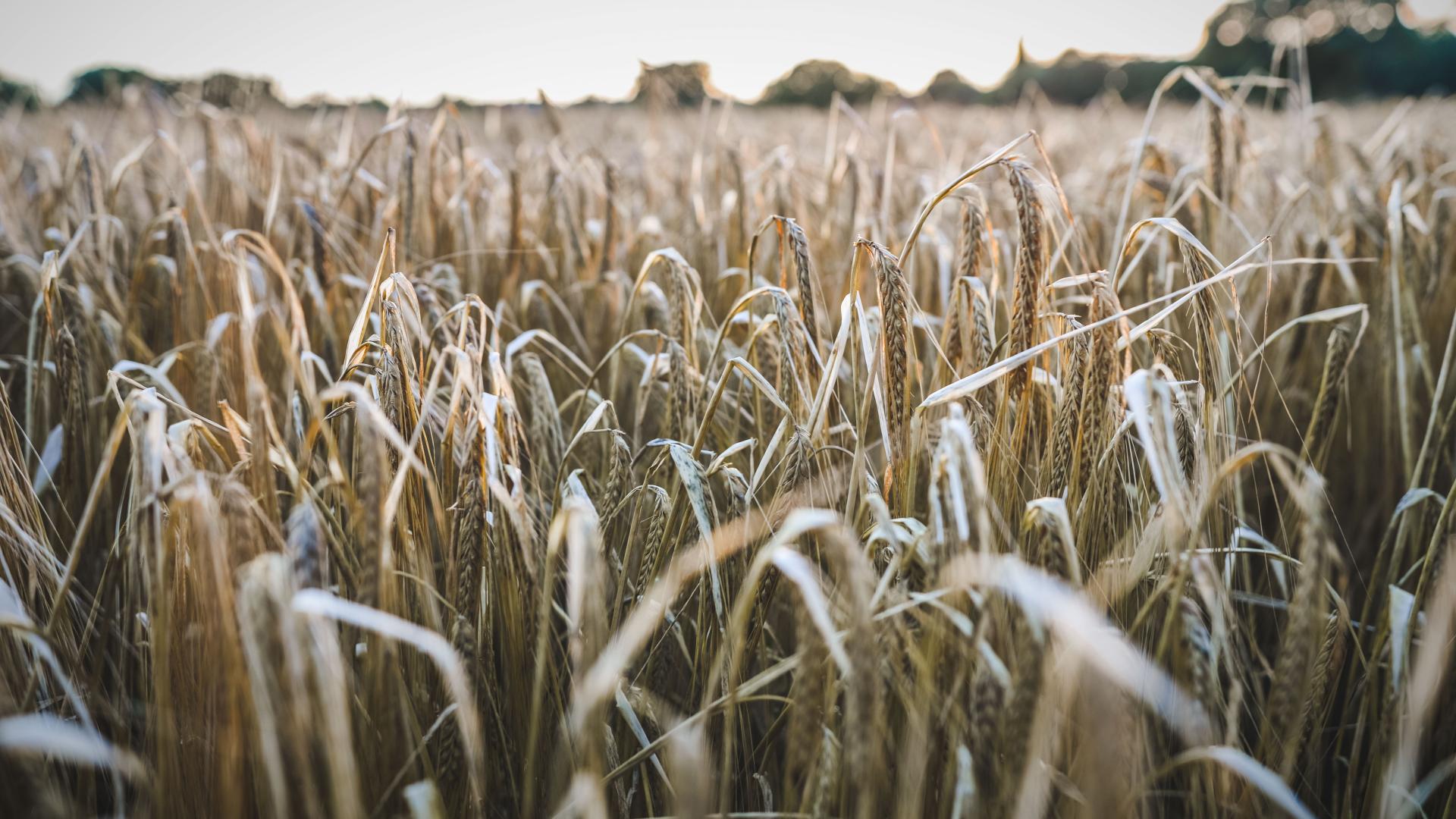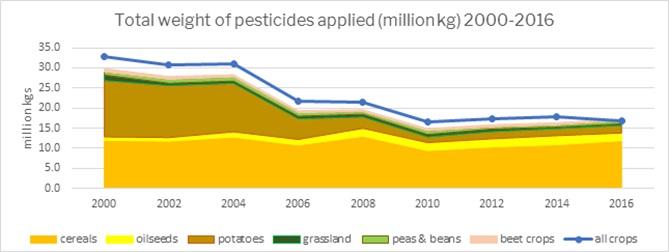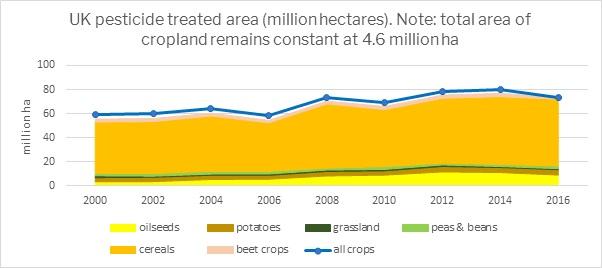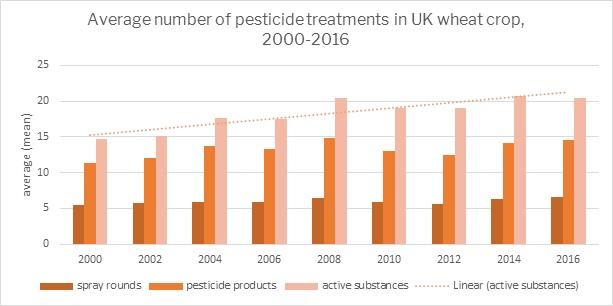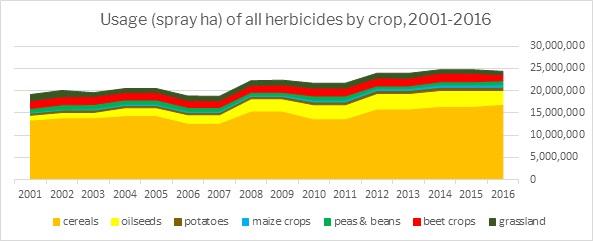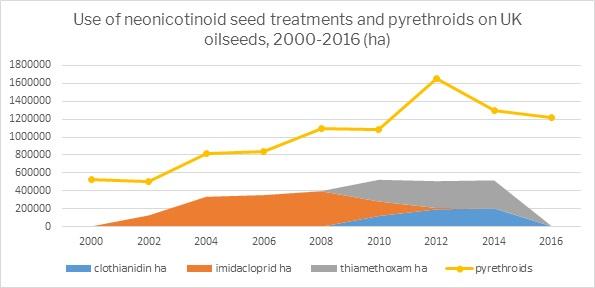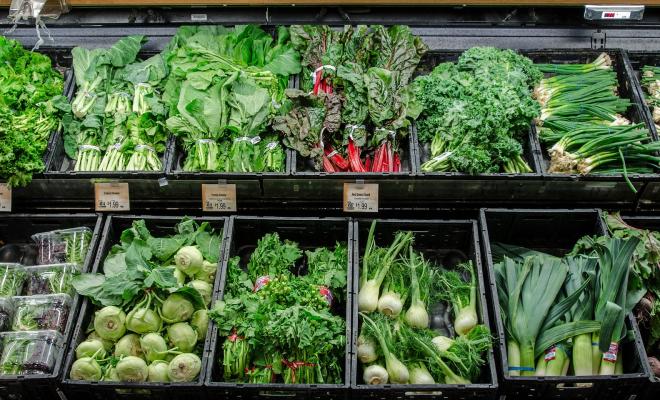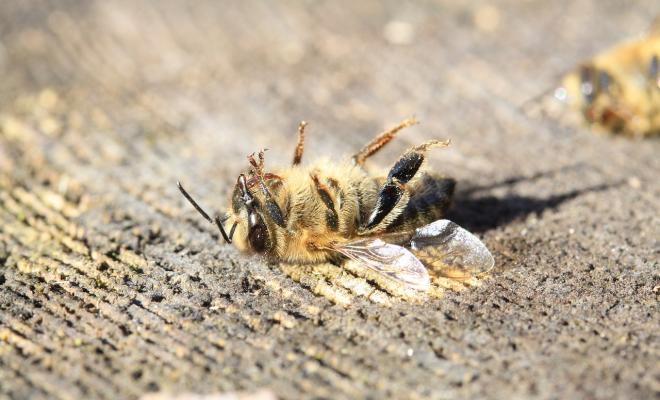05 Jun 2019
Rising pesticide use is harming wildlife – we need to change direction
Despite repeated claims to the contrary, pesticide use in UK agriculture is rising. Highly toxic active ingredients continue to be used and new equally harmful arrivals threaten to take the place of neonicotinoids, banned due to their impact on bees. In the pursuit of ever higher yields, we’ve developed a farming culture built upon use of chemicals, with pesticides routinely employed as an insurance policy. However, as yields plateau, farmers are struggling to survive with this high-input, high-yield farming model. At the same time the consequences are now becoming clear. Alarm bells are ringing as large numbers of wild species demonstrate steep declines. Intensive agriculture and pesticide use are clearly implicated.
It doesn’t have to be this way. Farming with reduced pesticide use can be more profitable and take advantage of the ecosystem services provided by a range of beneficial organisms which are so often harmed by pesticides. It’s essential that farming shifts urgently to more sustainable methods of pest and disease control.
The government has clearly signalled, through the Agriculture Bill, its intention to reward farmers for providing public goods that will deliver a cleaner, greener countryside. It’s also committed to putting integrated pest management (IPM), which prioritises non-chemical methods of pest and disease control, at the heart of its 25 Year Environment Plan. If it’s serious about halting the decline in wildlife and protecting the building blocks which nature provides for us, the government must honour its commitments, set clear targets for genuine reductions in pesticide use and fully support farmers to adopt IPM as a core practice at the heart of crop protection.
The truth about the growing use of pesticides
It’s commonly claimed by the farming industry1 that the use of pesticides in UK agriculture is decreasing. This claim is based on the most common metric used to measure pesticide use, weight. Examined in isolation, this claim is correct: overall pesticide use in the UK has fallen from approximately 33 million kg in 2000, to 17 million kg in 20162. However, this fall in use is primarily due to reduction in the weight of just one pesticide (sulphuric acid) on one crop (potatoes), which accounts for just 1% of UK agricultural area. (See brown band in graph below3).
The focus on weight of pesticides masks key growth trends
The focus on weight as a measure of pesticide use gives a false impression. Consideration of three other metrics demonstrates rising overall pesticide use: area treated (measured as ‘spray hectares’); frequency of applications; and the number of active ingredients used (one pesticide product may contain several ‘actives’).
The vast majority of pesticides used are for crop production4. Crops may be treated multiple times, with a number of different products, containing a variety of active ingredients. As a consequence, while UK cropland covers an area of approximately 4.6 million hectares (ha), the area treated (the sum of all active ingredients used, multiplied by area treated) is many times larger, and is growing. Department for Food, Environment and Rural Affairs (Defra) figures show that the total treated area has increased from 59 million spray ha in 2000, to 73 million spray ha in 2016 – a rise of 24%. The average number of active ingredients being applied to an average field has increased from 12.8 per ha in 2000, to 15.9 per ha in 2016.
Analysis of the figures for different crop classes demonstrates that for cereals the weight of pesticide applied has not decreased, but remained stable, and the number of pesticide applications has risen. In oilseed crops, both the weight of pesticides and the spray hectares have been increasing since 2000.
It is common practice to apply two or more pesticide products in a single spray pass on a field, and individual pesticide products can contain a number of active ingredients. Taking a closer look at individual crops demonstrates that for wheat, all three averaged metrics have been rising from 2000 to 2016. Spray passes have increased from 5.5 to 6.6; products used from 11.4 to 14.5; and active substances from 14.7 to 20.5. Similar growth trends are observed for potatoes: spray passes rising from 12.1 to 15.9; products from 15.2 to 24.4; and actives from 21.6 to 315.
Despite a fall in overall weight of pesticide used, when measured by all other available metrics pesticide use is clearly on the rise, amply demonstrating that weight is a wholly inadequate metric for pesticide measurement.
We must end the use of highly toxic pesticides
Analysis of pesticide use must also take into account toxicity, in order to reflect pesticide impact on the environment. Efforts to reduce pesticide use should aim not only to reduce overall pesticide load, but to replace those which are most toxic. This principle lies behind the EU’s list of “candidates for substitution”, which aims for the most toxic pesticides to be substituted with less toxic alternatives6. However, it’s clear that some highly toxic pesticides continue to be used.
We can use an indicator such as Cornell University’s Environmental Impact Quotient (EIQ) to compare approximate toxicities7 for pesticides currently in use in the UK. The ecological component8 of the EIQ indicates toxicity to wildlife. The field rate9 ecological component of the top 50 UK pesticides averages 11.7, but certain pesticides stand out for their particularly high toxicity, and their continued use is cause for concern.
The fungicide chlorothalonil has a field rate ecological component of 33.1 (ie, high toxicity). It’s the most widely used pesticide in UK arable production, and its use has increased from less than 0.5 million kg in 2000 to over 2 million kg in 2016. The EU has recently announced a ban on this chemical. Another highly toxic pesticide of concern is the broad-spectrum herbicide pendimethalin, which has an EIQ ecological component of 55.8. Despite being included in the European Commission’s 2015 draft list of candidates for substitution, it was re-approved in 2017 and its use on cereals is rising. Greater emphasis must be placed on reducing the use of these and other highly toxic pesticides – otherwise we will continue with a cycle of allowing widespread use of harmful chemicals until one by one their use is banned.
A new class of pesticides known as neonicotinoids has grown in use substantially since 2000. The most widely used in 2016 was clothianidin, which was applied to 728,000 ha of arable crops. Clothianidin is one of three neonicotinoids that have now been banned by the EU for use on outdoor crops due to their overall impact on bee species. It’s important to note that this decision was made on the basis of sub-lethal impacts such as colony survival, or numbers of queens produced, which are not taken into consideration by EIQ calculations.
The three banned neonicotinoids were chiefly used as seed dressings, a clear example of prophylactic treatment, applied in advance of any pest attack. It’s been demonstrated that only a small proportion of these systemic pesticides remained within the crop plants. Up to 95% contaminated surrounding soil and water, being taken up by subsequent crops or adjacent wildflowers and other vegetation, acting as a route of transmission to affect pollinators10.
There’s a danger that these banned neonicotinoids will be replaced by new actives with a similar mode of action and toxicity. Sulfoxaflor is one such new insecticide, approved in several EU countries despite a number of studies showing negative impacts on bees. A recent review of data by the European Food Safety Authority (EFSA) identified a high risk to honeybees and bumble bees11. Sulfoxaflor is effectively a neonicotinoid, but has not been classified as one by the industry. One sulfoxaflor product has been approved for use in the UK for greenhouse use, with two products for outdoor use going through the approval process. There is a clear threat of harmful actives being replaced by equally harmful alternatives, and a clear need for sub-lethal effects of pesticides to be carefully considered when assessing their contribution to toxic load in the environment, and its likely harm to wildlife.
A set of more robust tests for assessing impacts on bees – the EFSA Bee Guidance document - which led to the ban on the three neonicotinoids has been under discussion in the EU since 2013 but has not yet been adopted12. It's important that these tests are adopted in full in the UK to stop new bee- harming pesticides coming into use.
The indirect impacts of pesticides must be taken into consideration
It’s also becoming clear that pesticide use can have indirect effects that are not due to direct toxicity or sub-lethal effects, but knock-on impacts. This is clearly illustrated in the case of broad-spectrum herbicides, where increasing the amount and range of herbicides used reduces abundance of non-crop plant species, reducing species diversity, habitat and food resources for insects, birds and animals. Herbicide usage (spray hectares) is rising, due to increased uses in cereals and oilseed crops. This is shown by the increase in treatment frequency. In 2001, only 4.0% of the oilseed area and 5% of cereals were being treated more than four times per year with herbicides. By 2016 this had increased to 22% of oilseed crops and 9% of cereals. Concerns about the indirect effects of herbicides have been growing, and there is a clear need for thorough and comprehensive research in this area.
The Cocktail Effect
An as-yet little-studied aspect of pesticide impact is their synergistic effect. Pesticides are often applied in combination, and the increasing number of actives being applied to agricultural soils means they will inevitably be present in the environment as mixtures, creating a synergistic cocktail.
There’s growing evidence that when pesticides are present in combination, this can change or amplify their impact on wildlife, for example changing behaviour and enzyme activity in earthworms13. Synergistic impacts are thought to have been the cause of significant deaths of honeybees visiting Californian almond groves due to simultaneous application of fungicides, and insecticides14 used to target moth pests. Studies of the specific pesticides used showed that the insecticides are more damaging to bees when applied in combination with fungicides.
The growth in number and combinations of actives used in UK crop production emphasises the urgency of both adequate monitoring and the introduction of targets for overall pesticide reduction.
Why is our use of pesticides increasing?
Defra chief scientist Ian Boyd and his co-author Alice Milner15 have highlighted as a problem the tendency for prophylactic use of pesticides as a first resort, when sparing use would be more appropriate. Consultation with farmers16 confirms that a risk-averse culture exists in farming, with pesticides regularly used as an insurance to protect crops. This has undoubtedly arisen due to a decades-long focus on yield as a key priority for farming, driven in part by the Common Agricultural Policy. As a consequence, we’ve adopted a high-input farming model with high-yielding seed varieties and artificial fertilisers, where investments and vulnerable crop varieties need to be protected.
As farm sizes have grown, farmers have relied increasingly on agronomists for advice. Agrochemicals have become increasingly complicated, further increasing farmers’ reliance on agronomists to determine pest control strategies. Agronomists themselves are risk averse, and often under pressure to promote pesticide sales because many of them are employed by agrochemical companies. Peer pressure within the farming community also affects farmer behaviour, as does the insistence by supermarkets and consumers for high aesthetic standards. Despite ever-increasing inputs, yields have plateaued and the net result is that farmers are investing more and more in protecting their crops while profits decline.
Undoubtedly there has been a severe shortage of advice, training and research for more sustainable methods of pest and disease contro17. The practice of IPM emphasises the need to prioritise non-chemical interventions, and only using pesticides as a last resort when threshold levels have been reached. The UK has an obligation under the EU Sustainable Use directive to promote IPM, and has made this a commitment under the 25 Year Environment Plan. These commitments must be honoured.
Does banning some pesticides lead to increased use of others?
It’s frequently claimed that withdrawal of specific actives leads to greater overall pesticide use. This was particularly notable in the case of the recent ban on neonicotinoids. Industry claimed neonicotinoids were essential for oilseed rape (OSR) production. A partial ban on their use on flowering crops was introduced in 2014, which led to suggestions that farmers were responding by increasing pyrethroid use. While this may have been the case for individual farmers, government figures for the UK as a whole demonstrate that rising pyrethroid use occurred over previous years in parallel with neonic use, and not as a consequence of their withdrawal. Rather than using more pesticides, many farmers adapted to the ban through greater emphasis on IPM, for example using earlier sowing dates, or experimenting with innovative strategies such as overwinter grazing of OSR to remove flea beetle pests.
What needs to change?
The many recent reports of severe declines across a range of different species including bees and hoverflies18 , butterflies19 , and farmland birds20 demonstrate that there’s something wrong in the countryside. It’s widely acknowledged that intensive agriculture is one of the main drivers of this change, and pesticide use is a key factor.
The scientific community is calling for a comprehensive revision of pesticide policy to deliver better monitoring and regulation of pesticides
Better regulation and monitoring are needed
The failure to address the cumulative, landscape-scale impacts of widespread pesticide use have been recognised by Defra chief scientist Ian Boyd and co-author Alice Milner21 : “There is no consideration of safe pesticide limits at landscape scales… the total pesticides used – and therefore the total environmental dose – is governed by market demand rather than by a limit on what the environment can endure… The current assumption underlying pesticide regulation - that chemicals that pass a battery of tests in the laboratory or in field trials are environmentally benign when they are used at industrial scales - is false.”
The pervasiveness of pesticides in the environment is highlighted by Professor Boyd, who noted that in the case of neonicotinoids, there was difficulty in performing field experiments on these chemicals because untreated ‘control’ plots were found to be contaminated22.
Milner and Boyd acknowledge that while the UK has one of the most developed regulatory and monitoring systems for pesticides, it has no systematic monitoring of pesticide residues in the environment, and no consideration of safe pesticide limits at landscape scales. They have called for regulation to be improved, with a much more rigorous authorisation and monitoring process encompassing the full range of toxic effects that could emerge when pesticides are used at scale, including long-term monitoring and assessment of unexpected impacts.
The UK must adopt a meaningful measure of pesticide use, not just a simple measure of weight of pesticide products used
The need for a new, more comprehensive metric for pesticide measurement has never been clearer, or more urgent. Consideration of the issues raised above demonstrates that not only is the current system of pesticide measurement by weight misleading, it’s wholly inadequate when attempting to assess the wide range of complex interactions pesticides have with each other and the natural world.
Defra has for many years acknowledged the inadequacy of our monitoring of pesticides, and that weight of pesticides applied is not a good measure of environmental impact:
“Reductions explained only in volume applied are meaningless with regard to risk as many new active substances are applied at much lower rates per hectare than the older products they are replacing, bringing about significant reductions in the weight applied, without necessarily resulting in any reduction of use or risk23.”
The UK does not currently have a standard system to assess the contribution of individual pesticides to overall toxic load on the environment, or to give clear signals to individual users of the relative toxicities of the products they’re using.
Various attempts have been made to assess the real-world environmental impact of pesticide usage24 and three different national risk indicators are currently in place in the EU. The Danish model of Pesticide Load Indicator25 (PLI) is a good example – for each pesticide product a PL is calculated from an assessment of the toxicity of the pesticide to humans; the toxicity of the pesticide to non-target species; and the persistence of the pesticide and its metabolites in the environment, which are combined to derive the load for each pesticide formulation. For a more accurate assessment of the true impact of pesticide use in the UK, it’s essential that a new metric is developed to assess the toxic load generated, and a national risk indicator model adopted as a matter of urgency.
Productive farming without pesticides
The need for sustained use of high levels of pesticide is far from proven – a recent French analysis26 of 946 farms demonstrated that pesticides are often over-used. The study estimated that in 59% of farms, pesticide use could be reduced by 42% without any negative effects on either productivity or profitability, equating to average reductions of herbicide (37%), fungicide (47%) and insecticide use (60%).
In the UK, a study of conservation agriculture practitioners has demonstrated that lower-input farming, with significant reductions in quantities of pesticide use, can often be more profitable27. Organic farming uses natural measures for controlling pests and diseases and can already perform well financially. A German study of winter wheat farming demonstrated that conversion to organic doubled profitability28. Faced with multiple environmental challenges of climate change, biodiversity loss, and exhaustion of our soils, measures to address these issues must be rewarded. The improved agricultural payment scheme being developed for the UK should recognise the multiple benefits delivered by systems-based farming approaches and create an even stronger economic case for organic farming29.
Cutting pesticide use could actually boost productivity in the long run30. An overlooked impact of pesticide use is the loss of ecosystem services. Beneficial insects such as carabid beetles are important slug predators; spiders are a valuable aphid control agent – such beneficial invertebrates can be significantly harmed by pesticide use. Worms are essential for soil health, but also shown to be affected by pesticides. Perhaps the most obvious ecosystem service threatened by pesticides is pollination31 with insects contributing £690 million annually to the UK in pollination services32.
Recommendations
A new system of pesticide measurement must be adopted
Despite industry claims to the contrary, pesticide use is continuing to rise, with devastating consequences for wildlife. The UK must commit to a pesticide reduction target in order to reverse these trends and set an adequate level of ambition. Weight is a wholly inadequate measure for pesticide reduction, and a new target must be developed based on alternative metrics. Current data collection and analysis in the UK include measurement of area treated by pesticides and frequency of treatment. These could form the basis of a pesticide reduction target in the short term while a more comprehensive system is developed.
Reduction of the overall toxic load on the environment is imperative.
Pesticides vary widely in their toxicity to humans, toxicity to wildlife, and persistence in the environment. A variety of indicators is currently in use around the world which assess these factors to estimate individual toxicity and overall toxic load. It’s essential that the UK develops and adopts its own risk indicator, which should form the basis of a new system of pesticide measurement for the UK, alongside a reduction target. Such a system would also enable farmers to make the most sustainable choices.
To date there has been no monitoring of the long-term impacts of pesticide use at scale, their synergistic or indirect impacts, or other unexpected effects of their use. In view of the alarming wildlife declines we are witnessing this must be addressed as a matter of urgency.
Integrated Pest Management must be promoted.
Alternative practices to pesticide use must be prioritised. Consultation with farming industry representatives has identified a number of key measures to promote uptake of IPM. It’s essential that the government ensures the necessary support is provided to enable farmers to adopt IPM, including better, independent agronomic advice, farmer training, and more emphasis on farmer-focused research into non-chemical options and low-input farming systems
Clear targets and guidance must be incorporated in national policy
The Agriculture Bill presents a perfect opportunity to reduce pesticide use through adoption of a pesticide reduction target, and a new metric for measuring pesticide use based on toxic load in the environment, alongside measures to support farmers adopting IPM. The new agricultural support scheme which is being developed to replace the Common Agricultural Policy should reward farmers for the public goods resulting from pesticide reduction, such as improved water quality and increases in wildlife.
The 25 Year Environment Plan sets out a commitment to protect crops while reducing the environmental impact of pesticides (and includes this Action in chapter 4:
Putting Integrated Pest Management (IPM) at the heart of a holistic approach, by developing and implementing policies that encourage and support sustainable crop protection with the minimum use of pesticides.
Defra has not set out how it will deliver this target. It reviewed its Pesticides National Action Plan (NAP) in 2018, but failed to include public consultation as stipulated by the EU Sustainable Use Directive. The NAP is clearly the place where measures should be presented for cutting pesticide use and increasing IPM, but has been criticised by the EC for its failure to include clear and measurable targets and indicators for implementing IPM and reducing the risks and impacts from pesticide use. Incredibly, despite these criticisms and failure to consult the public, George Eustice (as Minister) declared that the existing NAP was “fit for purpose”.
As the UK prepares to leave the EU, the government:
- must ensure that we have a robust system of pesticides monitoring and regulation;
- must help farmers to move away from over -reliance on harmful chemicals;
- must find solutions that will boost nature and the long-term resilience of our food production.
- 1NFU calls for sound science https://www.nfuonline.com/sectors/horticulture-and-potatoes/hort-and-pots-news/nfu-continues-to-call-for-sound-science/
- 2https://secure.fera.defra.gov.uk/pusstats/myindex.cfm
- 3https://secure.fera.defra.gov.uk/pusstats/myindex.cfm
- 4Grassland makes up the greatest agricultural area, but accounts for only 1% of spray hectares. Fruit and vegetables account for 11% of usage by weight, but account for less than 2% of agricultural area
- 5Data from UK Pesticide Usage Surveys, 2000 to 2016. https://secure.fera.defra.gov.uk/pusstats/surveys/index.cfm
- 6https://ec.europa.eu/food/plant/pesticides/approval_active_substances_en
- 7The EIQ is based on US practice and regulations which differ from the UK
- 8The EIQ considers three components: toxicity to farm workers, toxicity to consumers, and ecological toxicity. The ecological component only considers direct toxicity, not sub-lethal effects such as the impact on bee behaviour, or indirect effects, such as loss of habitat caused by broad spectrum herbicides
- 9Pesticides may be diluted. Field rate is the concentration at which it’s applied in practice
- 10https://www.nature.com/articles/nature13642
- 11https://www.efsa.europa.eu/en/efsajournal/pub/5633
- 12http://www.greenpeace.to/greenpeace/wp-content/uploads/2019/01/pesticides_beehealth.pdf
- 13https://www.nature.com/articles/s41598-018-21288-y
- 14https://www.mdpi.com/2075-4450/10/1/20/htm
- 15http://science.sciencemag.org/content/357/6357/123 2
- 16https://cdn.friendsoftheearth.uk/sites/default/files/downloads/cutting-pesticide-use-farmers-perspective_1.pdf
- 17https://cdn.friendsoftheearth.uk/sites/default/files/downloads/cutting-pesticide-use-farmers-perspective_1.pdf
- 18https://www.ceh.ac.uk/news-and-media/news/widespread-losses-among-pollinating-insects-britain
- 19http://jncc.defra.gov.uk/page-4236
- 20https://www.rspb.org.uk/our-work/conservation/projects/state-of-nature-reporting
- 21http://science.sciencemag.org/content/357/6357/1232
- 22https://www.nature.com/articles/s41559-018-0557-8
- 23https://secure.fera.defra.gov.uk/pusstats/surveys/documents/guide.pdf
- 24SYNOPS, developed in Germany in the 1990s to consider farm-scale impacts; I-Phy, which evaluates the potential for water and air contamination; the Environmental Yardstick for Pesticides (EYP) developed in the Netherlands; the Norwegian pesticide risk indicator (NERI) and the Danish Pesticide Load Indicator
- 25http://www.europarl.europa.eu/RegData/etudes/STUD/2018/627113/EPRS_STU(2018)627113_EN.pdf
- 26https://www.theguardian.com/environment/2017/apr/06/farms-could-slash-pesticide-use-without-losses-research-reveals
- 27Gary Markham, Land Family Business. Presentation to Groundswell, 28 June 2018.
- 28Batáry et al, 2017 www.nature.com/articles/s41559-017-0272-x
- 29https://eftec.co.uk/project/natural-capital-balance-sheet-organic-dairy-farm-cholderton-estate
- 30https://policy.friendsoftheearth.uk/opinion/why-supporting-nature-friendly-farming-essential-productivity
- 31https://www.ipbes.net/sites/default/files/downloads/pdf/individual_chapters_pollination_20170305.pdf
- 32https://www.reading.ac.uk/web/files/food-security/cfs_case_studies_-_sustainable_pollination_services.pdf


